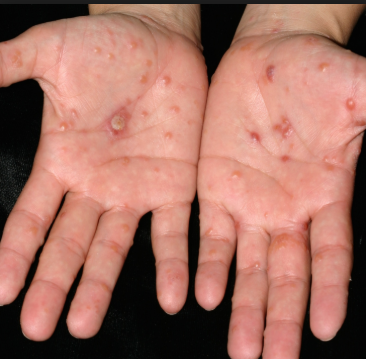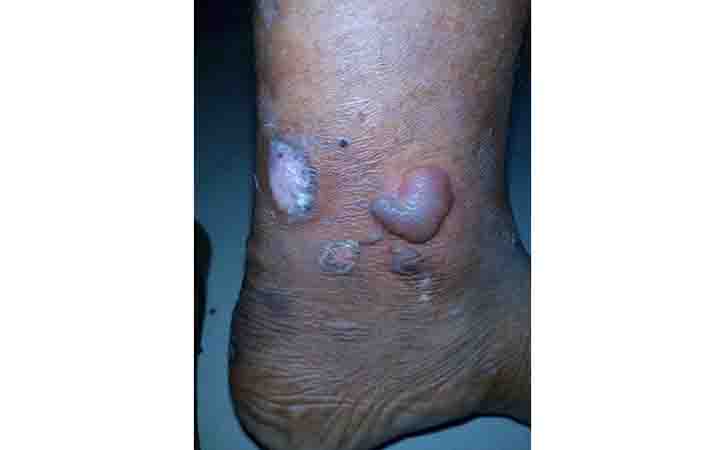Pompholyx
Dyshidrotic eczema (pompholyx) is a type of eczema (dermatitis) of unknown cause that is characterized by a pruritic vesicular eruption on the fingers, palms, and soles. The condition affects teenagers and adults and may be acute, recurrent, or chronic. A more appropriate term for this vesicular eruption is pompholyx, which means bubble. The clinical course of dyshidrotic eczema can range from self-limited to chronic, severe, or debilitating. Pompholyx can sometimes be confused with similar-looking conditions. The condition’s unresponsiveness to treatment can be frustrating for the patient and physician.

Some believe the terms pompholyx and dyshidrosis are obsolete and favor a new term, such as “acute and recurrent vesicular hand dermatitis.” The etiology of dyshidrotic eczema is unresolved and is believed to be multifactorial. Dyshidrotic eczema is considered to be a reaction pattern caused by various endogenous conditions and exogenous factors.
In dyshidrotic eczema, notice blisters forming on fingers, toes, hands, or feet. The blisters may be more common on the edges of these areas and may weep fluid. Sometimes, large blisters will form, which can be particularly painful. The blisters will usually be very itchy and may cause skin to flake. Affected areas may become cracked or painful to the touch.



The blisters may last up to three weeks before they begin to dry. As the blisters dry up, they’ll turn into skin cracks that may be painful. If scratching the affected areas skin may seems thicker or feels spongy.
The skin can sometimes become infected. Signs of an infection can include the blisters becoming very painful and oozing pus or becoming covered in a golden crust.
The blisters will usually heal within a few weeks.
It’s not clear exactly what causes pompholyx, but it may be triggered or made worse by:
- a fungal skin infection – this may be on the hands or at a distant site from the blisters (such as in between the toes) and will need treating
- a reaction to something that has touched your skin – such as certain metals (particularly nickel), detergents, household chemicals, soap, shampoo, cosmetic products or perfume
- Atopy – As many as 50% of patients with dyshidrotic eczema have reportedly had personal or familial atopic diathesis (eczema, asthma, hay fever, allergic sinusitis). The serum immunoglobulin E (IgE) level frequently is increased, even in patients who do not report a personal or familial history of atopy.
- stress
- sweating – pompholyx is more common in spring and summer, in warmer climates, and in people with hyperhidrosis (excessive sweating)
- Genetic factor – Monozygotic twins have been affected simultaneously by dyshidrotic eczema. The pompholyx gene has been mapped to band 18q22.1-18q22.3 in the autosomal dominant form of familial pompholyx.
In many cases, pompholyx will clear up on its own within a few weeks. The treatments may help relieve symptoms in the meantime.
Sometimes pompholyx may just occur once and never come back, but it often comes and goes over several months or years. Any of the triggers mentioned above can cause it to flare up again.
Occasionally, pompholyx can be more continuous and difficult to treat.
Protecting skin
Try to avoid contact with anything that might irritate skin, including soaps, shampoos and other household chemicals.
Use an emollient as a soap substitute and wear cotton-lined gloves when at risk of contact with other potentially irritating substances, such as when washing hair or doing housework.
Don’t burst the blisters – let them heal on their own. If they’re particularly big, doctor may drain them.
Treating the symptoms
The main treatments may recommend to treat the symptoms of pompholyx are similar to those used when treating atopic eczema, including:
- emollients (moisturizers) – use these all the time and instead of soap to stop skin becoming dry
- steroid cream – this reduces the inflammation and irritation and helps the skin to heal
Steroid cream may use for a short period of time, to minimise risk of steroid side effects. Wear cotton gloves at night to help the cream sink into the skin.
Also use:
- soaking hands in a dilute solution of potassium permanganate (1:10,000) for 10 to 15 minutes once or twice a day for up to 5 days
- antihistamines to relieve the itching.
Antibiotics may be prescribed if skin becomes infected.
Specialist treatments
If pompholyx keeps returning or is severe and doesn’t get better with the above treatments, doctor may suggest:
- phototherapy – controlled exposure to ultraviolet (UV) light
- steroid tablets or very strong steroid cream
- immunosuppressant creams or ointments, such as pimecrolimus or tacrolimus
- immunosuppressant tablets or capsules, such as ciclosporin or azathioprine
alitretinoin capsules – medication that helps improve severe eczema affecting the hands when other treatments haven’t worked
To confirm analyze, need to visit a doctor. Consultation with a psychologist may be helpful for stress reduction. Consultation with a dermatologist may be helpful for oral provocation tests for nickel, cobalt, or chromium salts. Before using antibiotic, must consult with a doctor.
- ABC Of Dermatology
- Clinical Dermatology
Pompholyx
TUI - Tibot Urgency Index


Dyshidrotic eczema (pompholyx) is a type of eczema (dermatitis) of unknown cause that is characterized by a pruritic vesicular eruption on the fingers, palms, and soles. The condition affects teenagers and adults and may be acute, recurrent, or chronic. A more appropriate term for this vesicular eruption is pompholyx, which means bubble. The clinical course of dyshidrotic eczema can range from self-limited to chronic, severe, or debilitating. Pompholyx can sometimes be confused with similar-looking conditions. The condition’s unresponsiveness to treatment can be frustrating for the patient and physician.



Some believe the terms pompholyx and dyshidrosis are obsolete and favor a new term, such as “acute and recurrent vesicular hand dermatitis.” The etiology of dyshidrotic eczema is unresolved and is believed to be multifactorial. Dyshidrotic eczema is considered to be a reaction pattern caused by various endogenous conditions and exogenous factors.
In dyshidrotic eczema, notice blisters forming on fingers, toes, hands, or feet. The blisters may be more common on the edges of these areas and may weep fluid. Sometimes, large blisters will form, which can be particularly painful. The blisters will usually be very itchy and may cause skin to flake. Affected areas may become cracked or painful to the touch.



The blisters may last up to three weeks before they begin to dry. As the blisters dry up, they’ll turn into skin cracks that may be painful. If scratching the affected areas skin may seems thicker or feels spongy.
The skin can sometimes become infected. Signs of an infection can include the blisters becoming very painful and oozing pus or becoming covered in a golden crust.
The blisters will usually heal within a few weeks.
It’s not clear exactly what causes pompholyx, but it may be triggered or made worse by:
- a fungal skin infection – this may be on the hands or at a distant site from the blisters (such as in between the toes) and will need treating
- a reaction to something that has touched your skin – such as certain metals (particularly nickel), detergents, household chemicals, soap, shampoo, cosmetic products or perfume
- Atopy – As many as 50% of patients with dyshidrotic eczema have reportedly had personal or familial atopic diathesis (eczema, asthma, hay fever, allergic sinusitis). The serum immunoglobulin E (IgE) level frequently is increased, even in patients who do not report a personal or familial history of atopy.
- stress
- sweating – pompholyx is more common in spring and summer, in warmer climates, and in people with hyperhidrosis (excessive sweating)
- Genetic factor – Monozygotic twins have been affected simultaneously by dyshidrotic eczema. The pompholyx gene has been mapped to band 18q22.1-18q22.3 in the autosomal dominant form of familial pompholyx.
In many cases, pompholyx will clear up on its own within a few weeks. The treatments may help relieve symptoms in the meantime.
Sometimes pompholyx may just occur once and never come back, but it often comes and goes over several months or years. Any of the triggers mentioned above can cause it to flare up again.
Occasionally, pompholyx can be more continuous and difficult to treat.
Protecting skin
Try to avoid contact with anything that might irritate skin, including soaps, shampoos and other household chemicals.
Use an emollient as a soap substitute and wear cotton-lined gloves when at risk of contact with other potentially irritating substances, such as when washing hair or doing housework.
Don’t burst the blisters – let them heal on their own. If they’re particularly big, doctor may drain them.
Treating the symptoms
The main treatments may recommend to treat the symptoms of pompholyx are similar to those used when treating atopic eczema, including:
- emollients (moisturizers) – use these all the time and instead of soap to stop skin becoming dry
- steroid cream – this reduces the inflammation and irritation and helps the skin to heal
Steroid cream may use for a short period of time, to minimise risk of steroid side effects. Wear cotton gloves at night to help the cream sink into the skin.
Also use:
- soaking hands in a dilute solution of potassium permanganate (1:10,000) for 10 to 15 minutes once or twice a day for up to 5 days
- antihistamines to relieve the itching.
Antibiotics may be prescribed if skin becomes infected.
Specialist treatments
If pompholyx keeps returning or is severe and doesn’t get better with the above treatments, doctor may suggest:
- phototherapy – controlled exposure to ultraviolet (UV) light
- steroid tablets or very strong steroid cream
- immunosuppressant creams or ointments, such as pimecrolimus or tacrolimus
- immunosuppressant tablets or capsules, such as ciclosporin or azathioprine
alitretinoin capsules – medication that helps improve severe eczema affecting the hands when other treatments haven’t worked
To confirm analyze, need to visit a doctor. Consultation with a psychologist may be helpful for stress reduction. Consultation with a dermatologist may be helpful for oral provocation tests for nickel, cobalt, or chromium salts. Before using antibiotic, must consult with a doctor.
- ABC Of Dermatology
- Clinical Dermatology




